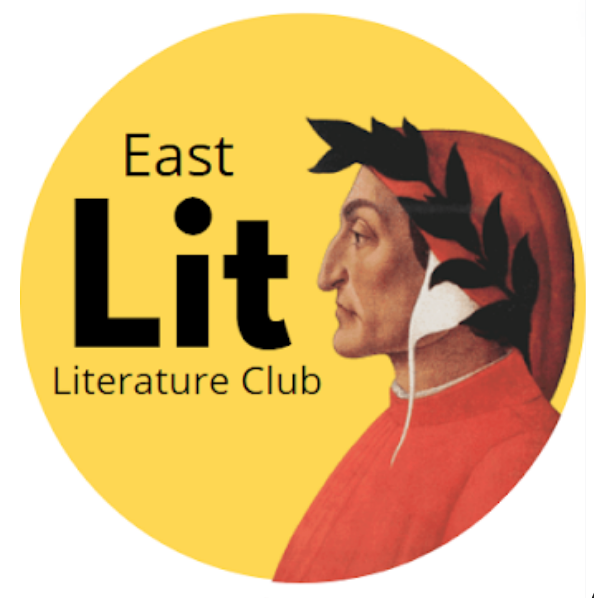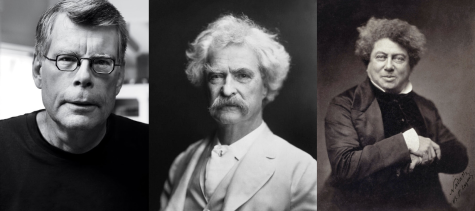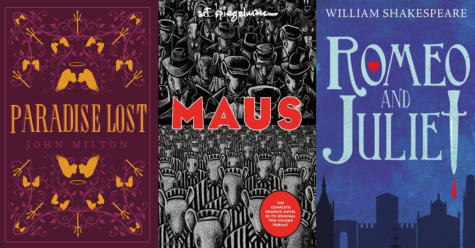East Literature Club Makes Book Recommendations for May

East Literature Club is a club at Cherry Hill East dedicated to people who love reading.
Paradise Lost – Review by Grant Yoon (‘23)
Milton’s Paradise Lost, despite being over three hundred years old, stays the passage of time with its intense and complex allegorical features. There is much to praise of Milton’s epic; the clear physical images conjured by the text’s descriptive language, the strength of its metaphors and allusions, the incorporation of classical mythology into a Christian context, and the strength of its allegorical figures (Satan especially, who receives unexpectedly human motives). With strikingly similar themes to modern artists who question the benevolence of the Christian God, Milton’s portrayal of God as well as Satan were extremely controversial in their inquisitive nature. God’s accountability for the fall of mankind is put at odds, with Milton’s explanation for the contradiction between God’s omnipotence and free will being explicitly recognized, and not fully answered by the text. The Almighty in Paradise Lost claims that since humans are warned about the coming temptation, they will be responsible for their fall. However, He knows before the fact that mankind will commit the Original Sin, contradicting the given explanation of free will with the logical proof of its negative. Similarly, the depiction of Satan as something other than the manifestation of pure evil, instead characterized by ambition and self-righteousness, then revenge, awarded the epic fervent criticism by religious figures of the time. Though adjusting to the convoluted syntax of Milton’s verse may initially be difficult, taking the time to develop appreciation for the poet’s style yields a work that displays some of the immense power of the various aspects of poetry, such as its capacity in syntax, trope, and diction in lending extremely specific meaning to the poet’s message; Paradise Lost is a beautiful example of the concise and visceral expression that only good verse can convey.
Maus – Review by Jamie McManmon (‘23)
Recent controversy surrounding the removal of the graphic novel Maus from some school curriculums around America raise the question of whether or not this novel is even worth a read. The answer is a tremendous “YES.” Art Speigelman was an established comic artist before his novel was published, as he was famously the creator of the Garbage Pail Kids. However, this step into nonfiction is considered his magnum opus. In the novel, Speigelman tells his own father’s story o surviving the Holocaust, but in a stylized way through depicting Jews as mice, Nazis as cats, and other nationalities as pigs and dogs.
This graphic novel manages to set itself apart from others in the Holocaust nonfiction genre not only through its medium, but also its themes. In an uncommon move for the genre, Speigelman sets part of his story in his own time, telling the story of himself and his father alongside the flashbacks to the Holocaust. This move is framed through Speigelman attempting to get his father to break his silence and tell him about his experience, but is really a method to unpack the generational trauma caused by the genocide. The novel tells both the story Speigelman’s father during the time he spent in Auschwitz, and in the modern day to show how the pain impacted him. The reader comes away from the book realizing that many survivors never really left those camps.
Romeo and Juliet – Review by Matthew Wang (‘25)
The name “Shakespeare” resonates with many people with his notable and attractive dramas such as “Hamlet” and “Macbeth” but there is no more famous play that Shakespeare wrote than that of Juliet and her Romeo. First premiered in 1597, The Tragedy of Romeo and Juliet follows not two lovers but two families and their rivalry, the Montagues and Capulets in the setting of fair Verona. In fact, Romeo Montague and Juliet Capulet were just two unfortunate protagonists destined as star-crossed lovers from these two feuding families. The tragedy begins by introducing and emerging the age-old blood feud followed by Romeo’s grievances for love, specifically for a girl named Rosaline. In his pursuit along with best friends Benvolio and Mercutio, he meets Juliet, a refined girl, and Romeo’s eyes and heart fall for her and Juliet in return. Their relationship and the trials they must face ultimately lead to their untimely deaths and the eventual reconciliation of their feuding families.
The Tragedy of Romeo and Juliet is often considered the greatest love story ever written, with many sources of media going as far as making this story a format for movies as well as being home to many of the finest scenes in literature. In all its pursuits, Romeo and Juliet’s death-fated relationship teaches that love is not something taken for granted and should be appreciated, for we only know how long we can have them. Besides that, the tragedy also plays with the concepts of fate versus free will, hate and violence, and even family which represents the relationships between characters who blame free will over fate or are more inclined to solve problems by violence and even how each person’s relationships with the two protagonists often show how life was viewed during 14th century times. The tragedy also responds to Shakespeare’s intelligence and clever use of wording as of course, he is first and foremost a poet. Many readers will find the Shakespearean language hard to read and Romeo and Juliet is no different. Shakespeare’s use of iambic pentameter and making sonnets only give the dialogue for the tragedy a more romantic sense.
Although many may not enjoy Shakespeare’s art due to its difficult language or may be difficult to understand the kind of style that he writes, Romeo and Juliet are one of the exceptions as many people like and continue to find joy in aspects of this fated couple’s story. Blockbusters such as Titanic and West Side Story often incorporate the use of fated love, heavy violence, and in the end, a tragic death that makes these movies very much investing and worthy of watching and these themes even help people reflect on their relationships and show the complexity of human love. If there is one work by Shakespeare that people should read when first trying or studying Shakespeare, it would have to be The Tragedy of Romeo and Juliet.
Stephen King – Biography by Deniz Alpdogan (‘22)
Stephen King is a ‘New York Times’-bestselling American author who specialized in the genres of horror, supernatural fiction, crime, fantasy, and supernatural fiction. King was born on September 21, 1947 in Portland, Maine. He grew up with divorced parents, Donald and Nellie Ruth Pillsbury King, and he and his brother frequently traveled between Connecticut and Indiana where their respective parents lived. After graduating from Lisbon Falls High School in 1966, he studied for a degree in English at the University of Maine.
During college, he published his first short story, which appeared in Startling Mystery Stories. After graduating from the University of Maine, he worked as a teacher while also starting his writing career. He first published under the pseudonym of Richard Bachman with his first horror novel, Carrie.
After the huge success of his first novel, he became a full time writer in 1973. He continued to write some of his popular works which include Salem’s Lot (1975), The Shining (1977), Cujo (1981) and IT (1986). He wrote several books under the pseudonym because he feared that the public would not accept more than one book from the same writer a year.
Many of his novels went on to become very successful Oscar winning film adaptations which include The Shining, The Shawshank Redemption, Misery, IT, The Green Mile, and several others. In honor of his success in writing and prolific output, Stephen King was awarded the National Medal of Arts in 2015. King continues to still write and be involved in provocative projects.
Mark Twain – Biography by Joelle Kang (‘23)
Famously known by his pen-name Mark Twain, Samuel Langhorne Clemens was born in Florida, Missouri, on November 30, 1835. His family moved to nearby Hannibal where he witnessed death at a young age. The city of Hannibal inspired many of Twain’s fictional locales such as “St. Petersburg” in both Tom Sawyer and Huckleberry Finn. River towns such as these in his novels contain an influx of drunkenness, poverty, death, and loneliness–all components of Twain’s difficult childhood.
He lost his father at an early age thus leading to his first job at the age of 12 as an apprentice printer at the Hannibal Courier. He became a licensed steamboat pilot in 1859 at the age of 23. As the Civil War began, people in Missouri split between supporting the Union or the Confederate States. Clemens joined the Confederate Army in June 1861 and later discontinued his enlistment as the volunteer unit disbanded. After this, he went to work as a reporter for the Virginia City Territorial Enterprise where his writing career first began.
His first novel was published in 1869 called The Innocents Abroad which became an instant bestseller. The next year, he married 24-year-old Olivia (Livy) Langdon, the daughter of a rich New York coal merchant. Together, they had four children together with the first-born – and the only son – who died at the age of only 19 months due to diphtheria. Some of Mark Twain’s most famous works including The Adventures of Huckleberry Finn and The Adventures of Tom Sawyer are still well-read novels today.
Alexandre Dumas – Biography by David Chehet (‘22)
Alexandre Dumas captivates the beauty behind an elegant and captivating mind. Born in 1802, of mixed racial heritage, Dumas lived a life obsessed to the pen. Though you may not recognize his name, if you’ve ever watched The Three Musketeers, you’ve witnessed Dumas’ incredible novel adapted into a Disney production. Furthermore, as English students at East, we all should have read arguably his most famous work, The Count of Monte Cristo, a mildly cliche yet simultaneously captivating plot that follows the revenge sequence of a man framed and locked up in prison for treason.
Though most people are unaware of this fact, Dumas broke grounds with his race coupled with his success among the French aristocracy. As a black man in the 19th century, racist ideology permeated throughout many different parts of the world, yet people became shocked when they learned that a black man penned their favorite novels of the time.

(Eric Li (’23))
Any film nerds reading this may know the reference to Dumas in Quentin Tarantino’s stunning film, Django Unchained, where Calvin Candy (Leonardo Dicaprio), the racist plantation owner, tells Dr. Schultz of his love for the Three Musketeers. Schultz, shocked by the ignorance of Candy, reveals to the racist plantation owner that the author of his famous book was a black man. Though a fictional story, this scene portrays the influence and groundbreaking role Dumas’ race played in such a time.
Dumas would eventually pass away in 1870, and his stunning work and influence in the world landed him a spot in the Parisian Pantheon of France, right in the midst of Paris, a beautiful landmark that marked his influence in the world.


